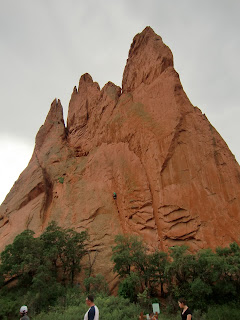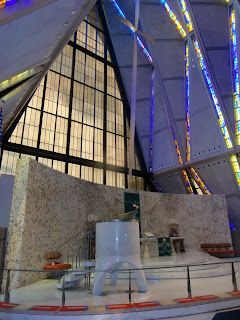15 years ago
Tuesday, August 6, 2013
Vacation Day 14 (Denver, CO to Grand Junction, CO)
I had to add a couple of pictures I got today from Rusty Givens. Here is Barbara and how she spent the day while Rusty and I talked Givens.
Monday, August 5, 2013
Vacation Day 13 (Denver and Louisville, CO)
Sunday (August 4) – Trip Day 13 – (Denver and
Louisville, CO) – We got up early and attended church in Louisville, CO, which
is a suburb of Denver. I chose that ward
to attend as it is in the same town as where my “cousin” Rusty Givens lives. We
spent a little over 12 hours at his house as he is a fabulous Givens research
and though we are not actually related (as DNA tells us) he has a ton of information
on my Givens line. In fact he had a long
table laid out with piles of research on my line and took most of the day to go
through all this and indicate what I would like.
Rusty at the scanner.
Anyway, after a long day we finally stumbled into our hotel
room after 10:30 PM. We were both
pleased with this day though – I got tons of new information and Barbara spent
most of the day working on her German genealogy.
Vacation Day 12 (Colorado Springs to Denver, CO)
Saturday (August 3) – Trip Day 12 – (Colorado
Springs, CO to Denver, CO) – My initial plan was for us to come up to Denver
and spend the day there touring the city.
As things ended up we spent most of the day in Colorado Springs and then
came up to Denver in the late afternoon. Our first stop was at the Garden of the Gods. In the background behind the park you get a
great view of Pike’s Peak which rises to 14,100 feet. We didn’t have time to ascend it but did get
a good view of it. Interestingly in
1893, Katharine Lee Bates, a long-time professor at Wellseley College in
Massachusetts, was lecturing at the summer session at Colorado Springs. During her visit she joined an expedition to
the summit of Pikes Peak in a prairie wagon.
Electrified by the beauty she saw atop Pikes Peak, she wrote the poem
that later became known as “America the Beautiful.”
Pikes Peak in the background - you can drive your car up to the summit, climb it, or take a cog railway.
The women's restroom entrance at the park has the information about "America the Beautiful."
Our first
stop was to Garden of the God’s, which is an area of red rock formations created
during a geological upheaval along a natural fault line millions of years
ago. This area had been privately owned
until 1909 when the family of the owner, according to the wishes of their
father deeded the park to the City of Colorado Springs to be forever a free
park. In 1971 it was designated a
National Natural Landmark.. The rock formations are spectacular and you
get to walk right at their bases.
These are the kissing camels.
There
were several climbers in the park so it was fun to watch them climb.
Barbara even got into the act.
This one is my favorite.
He is trying to get leverage to get up over that rise.
This is a nice shot from the visitor's center.
This is looking straight down to the original entrance of the cave.
Like all other caves of this nature it was
formed as water dissolved limestone beneath the surface of the earth leaving
passage ways and hollowed out “rooms.” It
is filled with stalactites and stalagmites of various sized and patterns. There were even a couple of columns where
stalactites and stalagmites grew together.
Stalactites from the roof.
Barbara the spelunker.
Stalactites and stalagmites of various sized and patterns.
This is called Bacon - it is a ribbon formation.
To the left is a stalactite that is 8 feet long. When it was actively growing it took a thousand years to grow one inch.
After our tour we started to Denver in a light rain. The trip took close to two hours as much of
the 55 mile trip was through construction zones on I-25. After getting our room we went out to eat and
that was when it really began to rain – literally in sheets. We heard later that some areas outside of
town got 4 inches of rain in 30 minutes.
There weren't any tornadoes but tornado warnings were out for several
counties around us.
Pikes Peak in the background - you can drive your car up to the summit, climb it, or take a cog railway.
We
next went to see Cave of the Winds which was just a few miles away. It was discovered in the 1800’s because of a
whistling sound made by the rock formation at the entrance of the cave when the
wind was blowing. We took the “easy”
tour (we didn’t have to crawl through passages or carry our own light.)
Stalactites from the roof.
After our tour we started to Denver in a light rain. The trip took close to two hours as much of
the 55 mile trip was through construction zones on I-25. After getting our room we went out to eat and
that was when it really began to rain – literally in sheets. We heard later that some areas outside of
town got 4 inches of rain in 30 minutes.
There weren't any tornadoes but tornado warnings were out for several
counties around us.
Friday, August 2, 2013
Vacation Day 11 (Estes Park, CO to Colorado Springs, CO)
Friday (August 2) – Trip Day 11 – (Estes Park,
CO to Colorado Springs, CO) – I am so tired of driving. It is harder here as the freeways are really congested
and there is a lot of construction on the I-25 (the main route south from
Denver to Colorado Springs. Denver was
like driving in Los Angeles except smaller thankfully. We only made one stop today (before a storm
hit). We stopped off at the Air Force Academy
just north or Colorado Springs.
After this we drove on to our motel as the rains began to
fall.
Thursday, August 1, 2013
Vacation Day 10 (Rocky Mountain National Park)
Thursday (August 1) – Trip Day 10 (Rocky
Mountain National Park) – I have long wanted to visit this park and was not
disappointed in the least. If you don’t
stop you can drive from Estes Park (where we are staying) to the top of the
Rockies in under an hour. Of course, we
made the trip with several stops. We
entered the park at the Fall River Visitor’s Center (8240 feet) and continued
on to Sheep Lake where we saw…sheep
We then continued up a steep windy road called
Trail Ridge Road through first pine forest and then, as we ascended into
mountain tundra and passed the two mile high point of the road.
This is a classic example of a meandering stream flowing through a meadow.
This is HIGH country and rising. We are still in the forest.
Passing the timber line and in the background are three cirques (glacial carved valleys on the side of mountains.
This is classic tundra. The land is frozen solid up to 5 months a year. There is a lot of vegetation here but it is mainly small plants that are very fragile. The rocks are worked to the surface during the freezing and thawing cycle each year.
This is a classic U shaped glacially formed valley.
We traveled higher but this sign tells it all - HIGH.
Another glacial landscape at over 12,000 feet.
We passed a whole herd of elk grazing along the
highway.
Also there was a little marmot sitting right at the side of the road. He let us walk right next to him. He was probably waiting for a handout.
The top of the Rockies - all these mountains are over 12,000 feet in elevation.
Eventually the road topped out at 12, 183
feet. Yes, walking up here takes extra exertion. The Alpine Visitor’s Center is unique as it
has large logs attached to the roof to catch snow to keep the shingles from
blowing off in the winter as the winds can reach 150 mph. The logs also help to
stabilize the structure.
We
continued down past the continental divide to Lake Irene where we had a picnic
lunch and then retraced our route back to Estes Park
What are the tall poles? They are snow poles telling the snow cleaning people where the trails are. They have to be tall, tall, tall here as the snow can get to be 35 feet deep.
One last picture - why the piles of dead trees in the forest? The Pine Bark beetle is killing millions of pines in the western United States. The only way to control them is to cut down the dead and dying trees and burn them. So everywhere you see piles of dead wood waiting for the winter when they burn them and avoid starting a forest fire.
This is a classic example of a meandering stream flowing through a meadow.
Subscribe to:
Posts (Atom)



























































